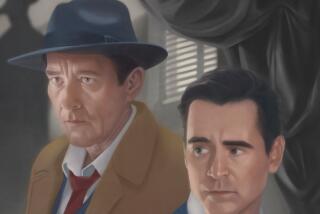Covering the bases in a noir triple play
- Share via
Fox Film Noir
(Fox, $15 each)
THE popular Fox noir DVD franchise returns with three vintage thrillers from the studio’s vaults: 1945’s “Fallen Angel,” 1950’s “No Way Out” and 1951’s “The House on Telegraph Hill.”
Fallen Angel
A year after producer-director Otto Preminger scored a critical and commercial success with his 1944 classic romantic film noir, “Laura,” with Gene Tierney and Dana Andrews, he reunited with several members of his “Laura” cast and crew, including composer David Raksin and star Andrews, for this underrated crime melodrama.
Though “Fallen Angel” was overshadowed then -- and now -- by “Laura,” it’s still crackerjack fun thanks to Preminger’s taut direction, Joseph La Shelle’s innovative cinematography and the crackling performances from the majority of the cast.
“Fallen Angel” also features a vivid, clever opening title sequence that propels viewers into the seedy action.
Andrews plays a penniless, handsome drifter who finds himself in a small California town. As soon as he’s kicked off the bus for not paying the full fare, he walks into a greasy spoon and falls head over heels in love with a beautiful, cynical waitress, Stella (a deliciously hard-boiled Linda Darnell). But he has a lot of competition for her attention, including a brutal detective (Charles Bickford), the elderly diner owner (Percy Kilbride) and a slick jukebox repairman (Bruce Cabot).
Though Stella gives Andrews’ Eric the cold shoulder, he believes that if he had enough money, she would fall for him. So Eric ends up marrying the prim, proper June (Alice Faye) for her money. But his plans go awry when Stella is found murdered in her apartment.
“Fallen Angel” marked a dramatic departure for Faye, who from 1935 until 1943 was Fox’s leading musical star. “Fallen Angel” was her “comeback” vehicle after spending two years off the screen in a contract dispute. But drama wasn’t her strong suit -- Faye ended up leaving Fox after “Fallen Angel” because she was upset that studio boss Darryl Zanuck cut her song, “Slowly,” as well as her part.
Extras: Fact-filled, breezy commentary with film noir historian and author Eddie Muller and Andrews’ daughter, Susan Andrews.
*
No Way Out
The year 1950 saw the release of Joseph L. Mankiewicz’s best picture-winning “All About Eve” that garnered him directing and writing Academy Awards, and the debut of this riveting, controversial racial drama that Mankiewicz co-wrote and directed and that marked the feature film debut of Sidney Poitier, who was just 22 at the time.
Poitier gives a strong performance as Dr. Brooks, an earnest young intern at an urban county hospital. Assigned to the hospital ward one night, Brooks has to treat two bigoted brothers who were shot after a robbery attempt.
Sensing that the younger brother has a brain tumor, Brooks attempts a spinal tap while the older brother (a terrifying Richard Widmark) spews racial epithets at him. During the course of the procedure, the younger man dies, and Brooks wonders if he did the right thing. He requests an autopsy after his mentor (Stephen McNally) admits that a brain tumor was just one of many possible diagnoses.
Widmark’s character blames Brooks for his brother’s death and with the help of his brother’s naive ex-wife (a strong Darnell), he stirs up his cronies to seek revenge on the African American community.
Extras: Two newsreels and commentary from Muller.
*
The House on Telegraph Hill
In his audio commentary, historian Muller points out that this 1951 thriller directed by Robert Wise is not a true film noir but more an example of the “woman in jeopardy” flicks that were so popular after World War II.
“House” was specifically made to showcase the young Italian actress Valentina Cortese -- she was billed as Cortesa during her salad days -- whom Zanuck brought to Hollywood after World War II. He first cast her as a sexy immigrant in Jules Dassin’s 1949 film noir “Thieves’ Highway.” This thriller, though, was Cortese’s first starring role.
She gives a luminous turn as Victoria, a Polish woman who survived a German concentration camp only to assume the identity of her friend who died. Under the guise of her dead friend, she hopes to relocate to San Francisco because the woman had sent her infant son to live with her wealthy aunt before the war.
After sending a cable to the aunt, she gets a wire from a New York lawyer saying the aunt has died. Eventually, Victoria makes her way to New York to see the lawyer and ends up falling in love with her “son’s” trustee (Richard Basehart). After she marries him and moves to the aunt’s house, Victoria learns her husband and the boy’s governess are up to no good.
Though Cortese’s Hollywood career didn’t take off, she enjoyed much success in Europe, culminating with a 1974 best supporting actress nomination for “Day for Night.” She and Basehart married in 1951 and divorced in 1960.
Extras: Commentary from Muller, who was so taken with Cortese after he saw “Thieves’ Highway” when he was young that he became obsessed with the film noir genre.
-- Susan King
More to Read
Only good movies
Get the Indie Focus newsletter, Mark Olsen's weekly guide to the world of cinema.
You may occasionally receive promotional content from the Los Angeles Times.









